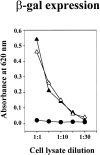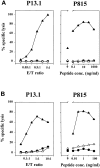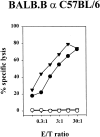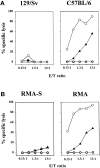Influences of transporter associated with antigen processing (TAP) on the repertoire of peptides associated with the endoplasmic reticulum-resident stress protein gp96
- PMID: 9236199
- PMCID: PMC2199000
- DOI: 10.1084/jem.186.3.461
Influences of transporter associated with antigen processing (TAP) on the repertoire of peptides associated with the endoplasmic reticulum-resident stress protein gp96
Abstract
The endoplasmic reticulum (ER)-resident stress protein gp96 induces protective immunity and specific cytotoxic T lymphocyte (CTL) responses against antigens expressed in those cells it has been isolated from. This ability is based on peptides associated with gp96. Because gp96 is located inside the ER, our experiments address the question whether or not the repertoire of peptides associated with gp96 is influenced by the transporter associated with antigen processing (TAP). For this purpose, gp96 was isolated from cells with and without a TAP defect and used for immunization of mice. We found that for some antigens the association of peptides with gp96 required functional TAP molecules, whereas the association of peptides from other antigens was TAP independent. In the case of a TAP-dependent association of peptides with gp96, our results prove that peptide binding by gp96 in vivo occurs inside the ER and is not an artifact induced by cell lysis during the gp96 purification. The finding that some antigens can also associate with gp96 in the absence of functional TAP molecules indicates that the repertoire of peptides bound by gp96 truly reflects the entire repertoire of peptides present inside the ER and not only those peptides transported by TAP. These results, together with the earlier finding that the gp96 peptide repertoire is independent of the major histocompatibility complex molecules expressed by the cell gp96 is isolated from, give the theoretical foundation for the ability of gp96 to induce CTL responses against all kinds of intracellular antigens.
Figures





Similar articles
-
The endoplasmic reticulum-resident stress protein gp96 binds peptides translocated by TAP.Eur J Immunol. 1997 Apr;27(4):923-7. doi: 10.1002/eji.1830270418. Eur J Immunol. 1997. PMID: 9130645
-
Cross-priming of minor histocompatibility antigen-specific cytotoxic T cells upon immunization with the heat shock protein gp96.J Exp Med. 1995 Sep 1;182(3):885-9. doi: 10.1084/jem.182.3.885. J Exp Med. 1995. PMID: 7650492 Free PMC article.
-
Immunization with tumor-associated epitopes fused to an endoplasmic reticulum translocation signal sequence affords protection against tumors with down-regulated expression of MHC and peptide transporters.Int Immunol. 2001 Mar;13(3):265-71. doi: 10.1093/intimm/13.3.265. Int Immunol. 2001. PMID: 11222495
-
Spotlight on TAP and its vital role in antigen presentation and cross-presentation.Mol Immunol. 2022 Feb;142:105-119. doi: 10.1016/j.molimm.2021.12.013. Epub 2021 Dec 29. Mol Immunol. 2022. PMID: 34973498 Free PMC article. Review.
-
TAP-independent delivery of antigenic peptides to the endoplasmic reticulum: therapeutic potential and insights into TAP-dependent antigen processing.J Immunother. 1998 Mar;21(2):127-31. doi: 10.1097/00002371-199803000-00006. J Immunother. 1998. PMID: 9551364 Review.
Cited by
-
gp96-peptide vaccination of mice against intracellular bacteria.Infect Immun. 2001 Jun;69(6):4164-7. doi: 10.1128/IAI.69.6.4164-4167.2001. Infect Immun. 2001. PMID: 11349093 Free PMC article.
-
Heat shock fusion proteins as vehicles for antigen delivery into the major histocompatibility complex class I presentation pathway.Proc Natl Acad Sci U S A. 1997 Nov 25;94(24):13146-51. doi: 10.1073/pnas.94.24.13146. Proc Natl Acad Sci U S A. 1997. PMID: 9371814 Free PMC article.
-
Ovalbumin-derived precursor peptides are transferred sequentially from gp96 and calreticulin to MHC class I in the endoplasmic reticulum.J Immunol. 2010 May 15;184(10):5619-27. doi: 10.4049/jimmunol.0902368. Epub 2010 Apr 21. J Immunol. 2010. PMID: 20410492 Free PMC article.
-
Major histocompatibility complex class I viral antigen processing in the secretory pathway defined by the trans-Golgi network protease furin.J Exp Med. 1998 Sep 21;188(6):1105-16. doi: 10.1084/jem.188.6.1105. J Exp Med. 1998. PMID: 9743529 Free PMC article.
-
Discrete cleavage motifs of constitutive and immunoproteasomes revealed by quantitative analysis of cleavage products.J Exp Med. 2001 Jul 2;194(1):1-12. doi: 10.1084/jem.194.1.1. J Exp Med. 2001. PMID: 11435468 Free PMC article.
References
-
- Heike M, Blachere NE, Srivastava PK. Protective cellular immunity against a spontaneous mammary carcinoma from ras transgenic mice. Immunobiology. 1994;190:411–423. - PubMed
-
- Udono H, Srivastava PK. Comparison of tumor-specific immunogenicities of stress-induced proteins gp96, hsp90, and hsp70. J Immunol. 1994;152:5398–5403. - PubMed
-
- Blachere NE, Udono H, Janetzki S, Li Z, Heike M, Srivastava PK. Heat shock protein vaccines against cancer. J Immunother. 1993;14:352–356. - PubMed
Publication types
MeSH terms
Substances
LinkOut - more resources
Full Text Sources
Other Literature Sources
Research Materials
Miscellaneous

